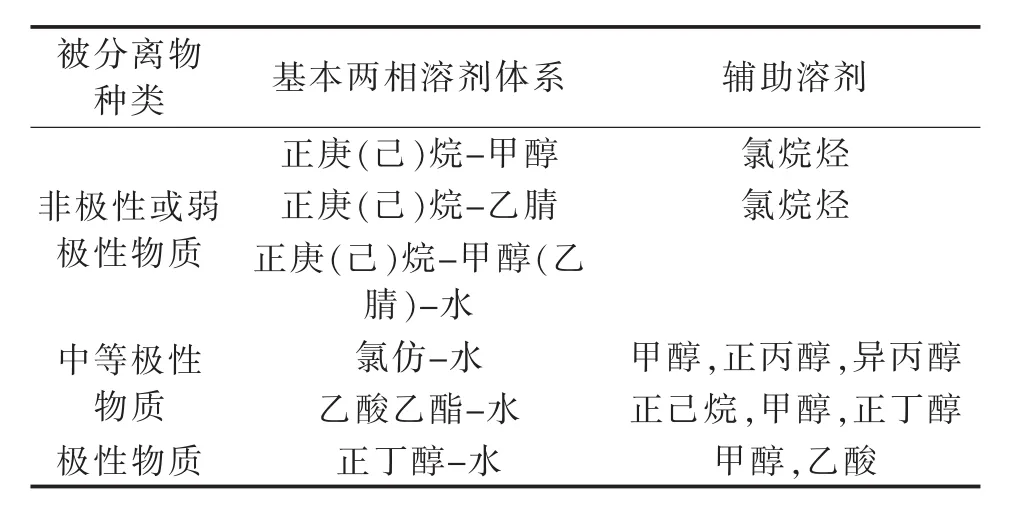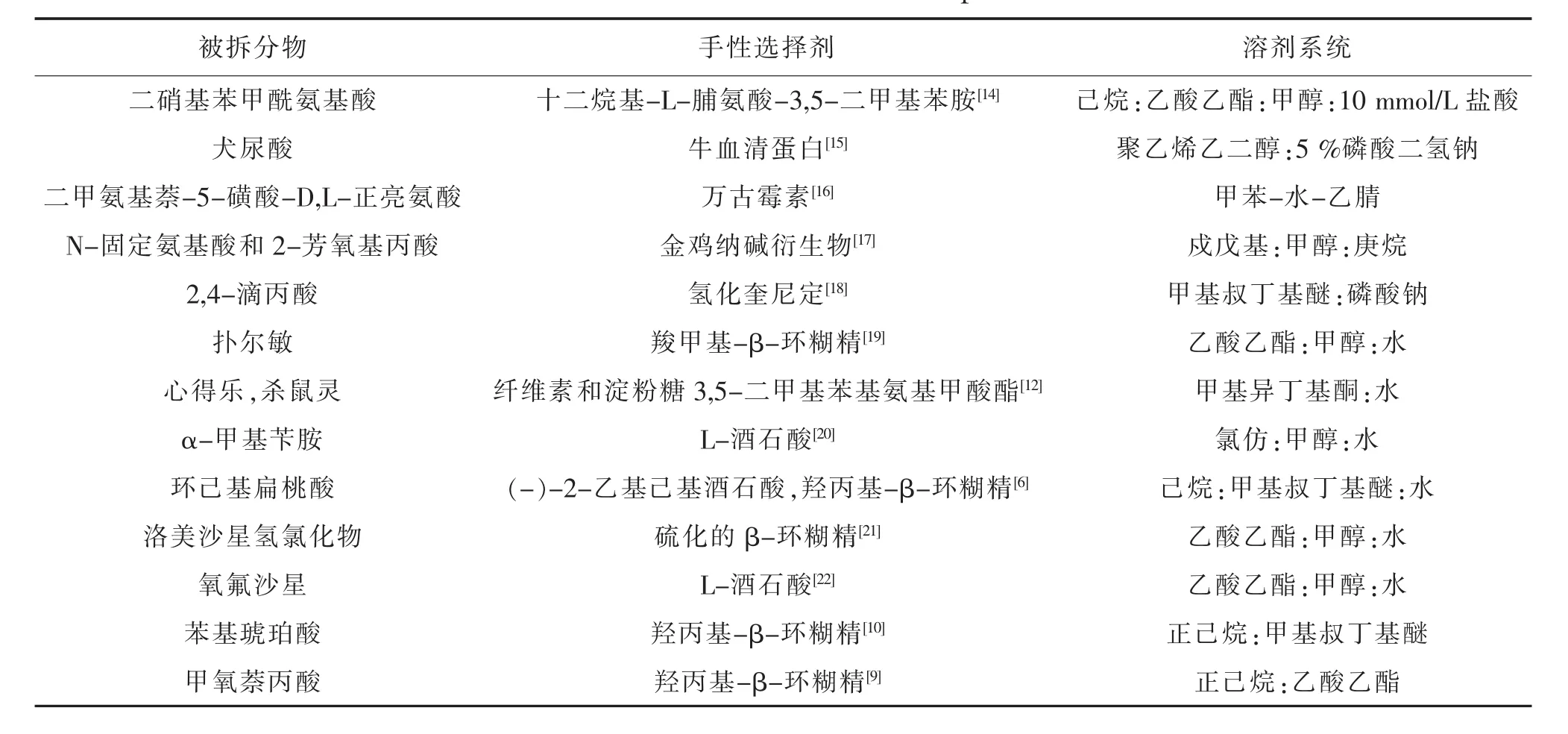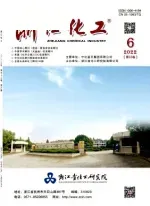高速逆流色谱在手性拆分中的应用
黄林兵
(浙江省天正设计工程有限公司,浙江 杭州 310012)
高速逆流色谱 (high-speed countercurrent chromatography,HSCCC)是利用两相溶剂体系在高速旋转的螺旋管内建立起一种特殊的单向性流体动力学平衡,其中一相作为固定相,另一相作为流动相,在连续洗脱的过程中能保留大量固定相的分离方法。由于不需要固体支撑体,物质依据其在两相中分配系数的不同而分离,因而解决了传统分离色谱因不可逆吸附而引起的样品损失、失活、变性等问题。由于这个特点,高速逆流色谱特别适合于天然生物活性成分的分离。而且由于被分离物质与液态固定相之间能够充分接触,使得样品的制备量大大提高,是一种理想的制备分离手段。
1 HSCCC技术
1.1 HSCCC发展过程
上世纪50年代,逆流分溶法(countercurrent distribution,CCD)被广泛应用于天然产物的分离。但是由于装置固有的一些缺陷,比如设备庞大复杂,易碎,溶剂体系容易乳化,溶剂消耗量大和分离时间太长等,很快在20世纪60年代被液相色谱淘汰。
在20世纪70年代,一种结合了逆流分溶和液相色谱的优点的方法,逆流色谱(countercurrent chromatography,CCC)法被用来进行连续的逆流分离。基于这种方法的液滴逆流色谱在1972年被商业化,并在20世纪七八十年代被广泛用于天然产物的分离。但是这种装置所需分离时间较长,通常要2~3 d,并且仅有有限的溶剂体系可以使用,且清洗较困难,在很多连接处容易出现渗漏,因此在20世纪70年代末,让位于其他新型逆流色谱技术。
在20世纪七八十年代,Ito教授研制出一种高效的逆流色谱系统,也就是现在的高速逆流色谱,可以在较短的时间内实现高效的分离,在高速旋转和分离过程中不易出现渗漏现象。
高速逆流色谱的目的主要是制备型分离,目前已被广泛应用于植物中生物碱类,黄酮类,萜类等物质的分离提取制备[1-3],并在金属离子分离方面也有应用[4]。
1.2 HSCCC优点
1)避免了样品在分离过程的不可逆吸附、分解等可能的样品变性问题。
2)滞留在柱中的样品可以通过多种洗脱方式予以完全回收。
3)粗样可以直接上样而不会对柱子造成任何损害。
4)柱子可以用合适的溶剂很容易的清洗,用空气或氮气干燥,然后注入新的溶剂后构成新的柱体,可重复使用。
5)通过改变溶剂体系,实现对不同记性物质的分离。
6)被分离组分在柱中保留时间或保留体积,可以通过其分配系数进行预测。
7)HSCCC的制备量可以比HPLC大,而且费用低,因为其不需要昂贵的色谱柱。
1.3 两相溶剂体系选择
高速逆流色谱发明人,美国国立卫生院Ito[5]教授针对高速逆流色谱的溶剂选择提出了8条原则。
1)在前人的研究中寻找已经被应用于相似物质分离的溶剂体系。
高速逆流色谱使用由互不相溶的溶液组成的两相溶剂体系,一相作为固定相,一相作为流动相。由于两相溶剂体系可以有多种任意的组成,这就导致了溶剂选择的困难。所以首先要查阅前人的工作,寻找类似的已经成功应用的溶剂体系,这样可以节约时间和经历。
如果没有找到合适的溶剂体系,那么在通过实验确定溶剂体系时,需要注意,分析物要在系统中可溶并且稳定;溶剂体系应由两相以合适的体积比形成,以避免溶剂浪费;分析物应在两相中有合适的分配系数;溶剂体系可以在柱中产生合适的固定相保留值。
2)寻找分析物分配系数K在0.5~1之间的体系。
过小的分配系数K会导致大部分溶质都在溶剂前端,引起过小的解析率;过大的分配系数K会产生较宽的峰型,并且洗提时间也会增大。
3)根据两相溶剂体系中油相的疏水性,系统性的寻找合适的溶剂体系。
如果目标产物的极性并不明确,可以从中等极性的溶剂体系,比如庚烷-乙酸乙酯-甲醇-水(体积比 3∶5∶3∶5)开始尝试。如果目标产物是亲脂性的,那么就要选择疏水性的溶剂体系,比如庚烷-甲醇-水(体积比 10 ∶5 ∶5);相应的,如果目标产物是亲水性的,则需选择极性溶剂体系,比如丁醇-水(体积比 5 ∶5)。

表1 高速逆流色谱常见溶剂体系及其极性Table 1 Choice of the solvent system and its polar
4)当目标产物是羧酸类电负性物质,需要在溶剂系统中添加酸性物质来调节分配系数。
5)在分离两种类似物质时,两种物质的分配系数比,也就是分离因子要大于1.5。
6)可以通过分配系数的值来估计分离目标产物所需的溶剂体积。
当分配系数K为1时,洗提体积与柱体积是一致的;当分配系数大于1时,目标产物在洗提体积大于柱体积时出现;当分配系数小于1时,目标产物在洗提体积小于柱体积时出现。
7)固定相保留值越大,则峰解析率越好。
8)需要提前测量溶剂体系分为两相的时间。
如果溶剂体系可以在20 s内分为两相,则这种系统可以提供超过50%的固定相保留值。
9)样品溶液要与溶剂体系中的每一项都可形成两相。
当样品只溶于固定相中,则需在固定相中添加一定量的流动相,直至形成两相。当大量溶质溶解在两相溶液中时,由于相组成的改变,样品溶液可能会变成单一的均相,这时就需要加入大量的固定相或者流动相,直至重新出现两相。
一些常见的溶剂体系及其极性列在表1中。
针对手性拆分,也有一些特定的原则需要满足,手性选择剂需要在一相或者两相中可溶;消旋体应在两相中均可溶;消旋体的分配系数应在1 左右[6]。
2 高速逆流色谱在手性拆分方面的进展
手性分离技术已经在高效液相色谱,气相色谱和毛细管电泳中得到广泛应用[7-8],但在逆流色谱中应用很少。主要困难在于寻找合适的手性选择剂,它们在液相和混合溶剂中都要有很高的选择性,并且能将所要分离的手性异构体洗脱出。尽管进展不大,但还是有一些文献报道,将高速逆流色谱应用于手性拆分,如表2所示。
Shengqiang Tong[9]通过添加羟丙基-β-环糊精手性拆分甲氧萘丙酸,对比研究了9种溶剂系统以及8种水相pH对手性选择性和分配系数的影响,最终筛选出最优的实验操作条件,并且制备出的单体纯度超过99.5%。最终回收的药品回收率达到89%。该工作组的成员[10]同样利用羟丙基-β-环糊精作为手性拆分剂,成功拆分了单体纯度超过98.5%,回收率超过82%的苯基琥珀酸。同时其还提出了一种新型分离方法——两相识别技术[6],即在固定相和流动相中分别加入不同的亲脂和亲水的手性选择剂,对外消旋体进行手性拆分,他们在固定相中加入亲脂的(-)-2-乙基己基酒石酸,流动相加入亲水的羟丙基-β-环糊精,成功拆分出纯度达到99.5%的单体。
Perez[11]利用L-脯氨酸和4R-羟基-L-脯氨酸衍生物作为手性选择剂,通过优化溶剂体系,手性选择剂浓度,水相pH等实验操作条件,成功拆分了分离N-(3,5)-二硝基苯甲酰-亮氨酸和苯酮苯丙酸。Perez[12]也利用纤维素和淀粉糖3,5-二甲基苯基氨基甲酸酯,成功拆分出纯度为84%的心得乐和杀鼠灵。随着研究进一步发展,他们又分别利用[13]N-十二烷基-L-脯氨酸-3,5-二甲基苯胺和2-甲烷氧基乙基-L-脯氨酸-3,5-二甲基苯胺作为手性拆分剂,成功对亮氨酸进行了手性拆分。

表2 高速逆流色谱在手性拆分中的应用Table 2 The HSCCC in chrial separation
从表2可看出,目前常用的手性拆分剂是酒石酸及β-环糊精衍生物,以及一些天然蛋白质,这些手性拆分试剂均是在高效液相色谱,或者毛细管电泳中表现出良好的手性拆分性能,为了进一步提高拆分效率,减少拆分时间,这些已经在其他方法中被验证可行的手性拆分剂被用于高速逆流色谱中,并表现出优异的手性拆分性能。
高速逆流色谱在手性拆分上还有很大的发展空间,仍需进一步寻找新型手性拆分试剂,溶剂体系等,从而提高高速逆流色谱的应用范围。
[1]Yang F Q,Quan J,Zhang T Y,et al.Preparative separation of alkaloids from the root of Sophora flavescens Ait by pH-zone-refining counter-current chromatography[J].Journal of Chromatography A.1998,822(2):316-320.
[2]Yang F Q,Ito Y.Preparative separation of lappaconitine,ranaconitine,N-deacetyllappaconitine and N-deacetylranaconitine from crude alkaloids of sample Aconitum sinomontanum Nakai by high-speed counter-current chromatography[J].Journal of Chromatography A.2002,943(2):219-225.
[3]Cao X L,Tian Y,Zhang T Y,et al.Separation and purification of isoflavones from Pueraria lobata by high-speed counter-current chromatography[J].Journal of Chromatography A.1999,855(2):709-713.
[4]Ma Z M,Zhang L Z,Han S J.Separation of samarium,gadolinium,terbium,gysprosium,erbium and ytterbium by high -speed countercurrent chromatography with organophosphate ester[J].Journal of Chromatography A.1997,766(1-2):282-285.
[5]Ito Y.Golden rules and pitfalls in selecting optimum conditions for high-speed counter-current chromatography[J].J Journal of Chromatography A.2005,1065(2):145-168.
[6]Tong S,Yan J,Guan Y,et al.Separation of α-cyclohexylmandelic acid enantiomers using biphasic chiral recognition high-speed counter-current chromatography[J].Journal of Chromatography A.2010,1217(18):3044-3052.
[7]Bi W T,Tian M L,Row K H.Chiral separation and determination of ofloxacin enantiomers by ionic liquid-assisted ligand-exchange chromatography[J].Analyst.2011,136(2):379-387.
[8]Tian M L,Yan H Y,Row K H.Investigation of ofloxacin enantioseparation by ligand exchange chromatography[J].Journal of Chemical Technology and Biotechnology.2009,84(7):1001-1006.
[9]Tong S,Guan Y,Yan J,et al.Enantiomeric separation of(R,S)-naproxen by recycling high speed counter-current chromatography with hydroxypropyl-β-cyclodextrin as chiral selector[J].Journal of Chromatography A.2011,1218(32):5434-5440.
[10]Tong S,Yan J,Guan Y,et al.Enantioseparation of phenylsuccinic acid by high speed counter-current chromatography using hydroxypropyl-β-cyclodextrin as chiral selector[J].Journal of Chromatography A.2011,1218(33):5602-5608.
[11]Delgado B,Perez E,Santano M C,et al.Enantiomer separation by counter-current chromatography-optimisation and drawbacks in the use of L-proline derivatives as chiral selectors[J].Journal of Chromatography A.2005,1092(1):36-42.
[12]Perez E,Santos M J,Minguillon C.Application of cellulose and amylose arylcarbamates as chiral selectors in countercurrent chromatography[J].Journal of Chromatography A.2006,1107(1-2):165-174.
[13]Perez A M,Minguillon C.Retention of fluorinated chiral selectors in biphasic fluorinated solvent systems and its application to the separation of enantiomers by countercurrent chromatography[J].Journal of Chromatography A.2010,1217(7):1094-1100.
[14]Ma Y,Ito Y,Foucault A.Resolution of gram quantities of racemates by high-speed counter-current chromatography[J].Journal of Chromatography A.1995,704(1):75-81.
[15]Shinomiya K,Kabasawa Y,Ito Y.Enantiomeric separation of commercial D,L-kynurenine with an aqueous two-phase solvent system by cross-axis coil planet centrifuge[J].Journal of Liquid Chromatography&Related Technologies.1998,21(1-2):135-141.
[16]Duret P,Foucault A,Margraff R.Vancomycin as a chiral selector in centrifugal partition chromatography[J].Journal of Liquid Chromatography&Related Technologies.2000,23(2):295-312.
[17]Franco P,Blanc J,Oberleitner W R,et al.Enantiomer separation by countercurrent chromatography using cinchona alkaloid derivatives as chiral selectors[J].Analytical chemistry.2002,74(16):4175-4183.
[18]Gavioli E,Maier N M,Minguillon C,et al.Preparative enantiomer separation of dichlorprop with a cinchona-derived chiral selector employing centrifugal partition chromatography and high-performance liquid chromatography:A comparative study[J].Analytical chemistry.2004,76(19):5837-5848.
[19]Yuan L M,Liu J C,Yan Z H.Enantioseparation of chlorpheniramine by high speed countercurrent chromatography using carboxymethyl﹞β﹞cyclodextrin as chiral selector[J].Journal of liquid chromatography&related technologies.2005,28(19):3057-3063.
[20]Cai Y,Yan Z H,Zi M.Preparative enantioseparation of dl﹞α﹞methylbenzylamine by high-speed countercurrent chromatography using l﹞(+)﹞tartaric ccid as chiral selector[J].journal of liquid chromatography&related technologies.2007,30(9-12):1489-1495.
[21]Wei Y,Du S,Ito Y.Enantioseparation of lomefloxacin hydrochloride by high-speed counter-current chromatography using sulfated-β-cyclodextrin as a chiral selector[J].Journal of Liquid Chromatography&Related Technologies.
[22]Lv Y C,Yan Z H,Ma C.Preparative enantioseparation of ofloxacin by high speed countercurrent chromatography using L-(+)-tartaric acid as chiral selector[J].Journal of Liquid Chromatography&Related Technologies.2010,33(13):1328-1334.

